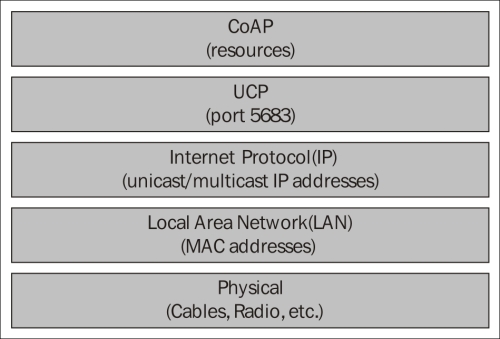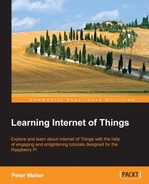As we have seen, HTTP is a tremendously popular protocol. In Chapter 3, The UPnP Protocol, we also saw the benefits of simplifying HTTP and using it over UDP instead of TCP. But for tiny resource-constrained devices that communicate over resource-constrained IP networks, HTTPU is not a practical option because it requires too many resources and too much bandwidth. This is especially the case when the underlying network limits the size of datagrams, which is the case when you use IPv6 over Low power Wireless Personal Area Networks (6LoWPAN), a radio networking protocol based on the latest version of Internet Protocol Version 6 (IPv6). Constrained Application Protocol (CoAP) is an attempt to solve this. In this chapter, we will show you how CoAP can be used in IoT by applying it to the sensor, actuator, and controller projects defined in the previous chapters.
In this chapter, you will learn the following:
- The basic operations available in CoAP
- How to publish CoAP resources
- How to subscribe to CoAP events
- How to use blocks to transport large content
- How to discover existing CoAP resources
- How to test CoAP resources
Tip
All of the source code presented in this book is available for download. The source code for this chapter and the next one can be downloaded from https://github.com/Clayster/Learning-IoT-CoAP.
The main difference between CoAP and HTTPU is that CoAP replaces the text headers used in HTTPU with more compact binary headers, and furthermore, it reduces the number of options available in the header. This makes it much easier to encode and parse CoAP messages. CoAP also reduces the set of methods that can be used; it allows you to have four methods: GET, POST, PUT, and DELETE. Also, in CoAP, method calls can be made using confirmable and nonconfirmable message services. When you receive a confirmable message, the receiver always returns an acknowledgement. The sender can, in turn, resend messages if an acknowledgement is not returned within the given time period. The number of response code has also been reduced to make implementation simpler. CoAP also broke away from the Internet Media Type scheme used in HTTP and other protocols and replaced this with a reduced set of Content-Formats, where each format is identified by a number instead of its corresponding Internet Media Type. A detailed list of the numbers assigned to different options, methods, status code, and Content-Formats used in CoAP can be found at http://www.iana.org/assignments/core-parameters/.
Apart from retaining the request/response capabilities of HTTP and a reduced set of methods and options, CoAP also provides a few new features. Like with HTTPU, CoAP supports multicasting. This can be used to detect devices or communicate through firewalls, as we saw in Chapter 3, The UPnP Protocol. CoAP also provides a set of useful extensions. One of these extensions provides a block transfer algorithm, which allows you to transfer larger amounts of data. (In constrained networks, large might be very small, compared to normal home or office IP networks.) Another extension allows you to have an event subscription and notification architecture where observable resources, which emit notifications when events occur, can be subscribed to. CoAP also supports encryption in the unicast case through the use of Datagram Transport Layer Security (DTLS). The unencrypted version of CoAP is displayed in the following protocol stack diagram:

Since CoAP is relatively new, the availability of development tools for this protocol is somewhat restricted. There exists an add-on to Firefox, which allows you to view and interact with CoAP resources. This is called Copper (Cu) and can be downloaded from https://addons.mozilla.org/en-US/firefox/addon/copper-270430/. A web-based CoAP test tool can be found at http://coap.me/, and a CoAP interoperability server can be found at http://vs0.inf.ethz.ch/.
Note
Other useful information related to CoAP can be found at http://coap.technology/.
